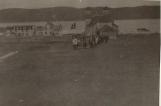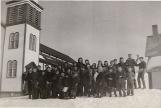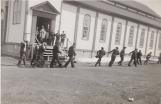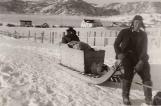1
Historical documents and records show that a Priest would accompany the French fishermen who came to our shores between 1504 and 1904. In 1816 a Priest by the name of Father Lalo was stationed in Cape Rouge Harbour, Newfoundland and would visit Conche Harbour, Newfoundland to offer services to the fishermen.Oral history tells us that Father Lalo had been a French Captain but when he learned of the deplorable conditions of those fishermen he decided to become a Priest. He returned to Conche, and with the help of the Irish settlers and the French fishermen he built a Chapel on a point of land which today is still known as Lalo's Point. Since the building of that first chapel there have been three other churches built on that same piece of land. The last Priest from France was Father Gour (1873-1883).
The church records in Conche date back to 1851. The records before that date were kept by the French Priest and are now in the Church records in Brest, France.
In 1904, the year in which France relinquished its rights on the French Shore of Newfoundland, Sacred Heart Parish was formally incorporated into the Roman Catholic Episcopal Corporation of Harbour Grace, Newfoundland. The Parish would have its headquarters at Conche and the Mission Communities were Croque, Grand Oies, Fishot Island, St. Juliens, Northeast Cape Rouge, Grey Islands, Englee, and St. Anthony.
With no roads in place, the only mode of traveling at this time was by boat in the summer and by dog teams in the winter so it was quite a task to get to those communities.
Even though those communities were officially a part of the Island of Newfoundland and the Harbour Grace Dioceses, there was still a French Priest stationed in Conche until the 1920's. The only difference was, they now came from Quebec instead of France. Some French Priests' from Quebec included Father Colbert (1898-1905) and Father Thibault (1906-1923).
The land for Sacred Heart Parish was granted on March 18, 1913 to the Roman Catholic Episcopal Corporation of Harbour Grace for the sum of $1.00. It became the site for the Roman Catholic Rectory, Sacred Heart All Grade School and Sacred Heart Church.
The Priests' who came to Conche became not only the spirtual leaders but also the community leaders. The community looked to them for guidance in religious, education, medical, social and economic development. Father William Hennebury was one such Priest. He came to Conche in 1939 and immediately immersed himself in the development of the communities. He became instrumental in building new schools and churches throughout the Parish. The next project he took upon himself was to organize the fishermen into a Co-operative and to secure funds from the Newfoundland government to build a bait depot for the fishermen landing their catches in Conche.
Father William Hennebury is still well remembered by the people whom he served. He is especially noted for his emphasis on the importance of education. As one former student, Gerald FitzGerald, put it, "He said to me, you are going to get your education and that is all there is to it".
2
Traditionally, new schools were blessed by the Parish Priest before they were opened. These were community events with much pomp and celebration as the following 1945 photo depicts.4
Teachers in many communities had their hands full. The following photo, taken in Conche, Newfoundland in the 1940's, depicts how one teacher would be in charge of numerous students, of many grades. As such, teachers would often look to the Parish Priest for guidance regarding the education of the children in their charge. As a result, the church ended up having much influence over the children's education.6
In the past, often as a result of isolation and poor transportation, death during childbirth would be a common occurence. One such death was that of Elizabeth (Lizzie) Bromley of Conche, Newfoundland in 1940. The funeral wake took place in the family home. Later, men in the community carried the casket to the church by sled, as shown in the following photograph.8
The following 1958 photograph is Sacred Heart Church and Rectory located in Conche, Newfoundland. This church was the third church constructed in Conche since initial settlement in the early 1800's. This church, like its predecessor, caught fire and burned to the ground in the 1970's.10
In the 1940's, with no roads in place, and so many communities involved in the Parish, the only mode of traveling at this time was by boat in the summer and by dog teams in the winter; therefore, it was quite a task to get to those communities. Usually, this involved two or three men, the Parish Priest, and a team of dogs gone from Conche for days at a time.12
For many years it was a common tradition to fire guns after a wedding ceremony. The act was a salute to the couple. The following 1945 photo depicts such an act partaken by the men from Conche, Newfoundland.13
A group of people would get together and fire off their guns for a wedding.1940
Conche, Newfoundland, Canada





